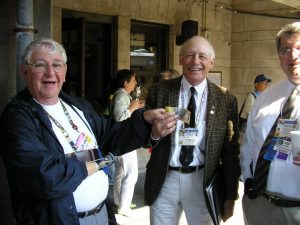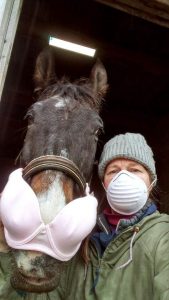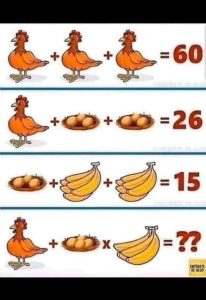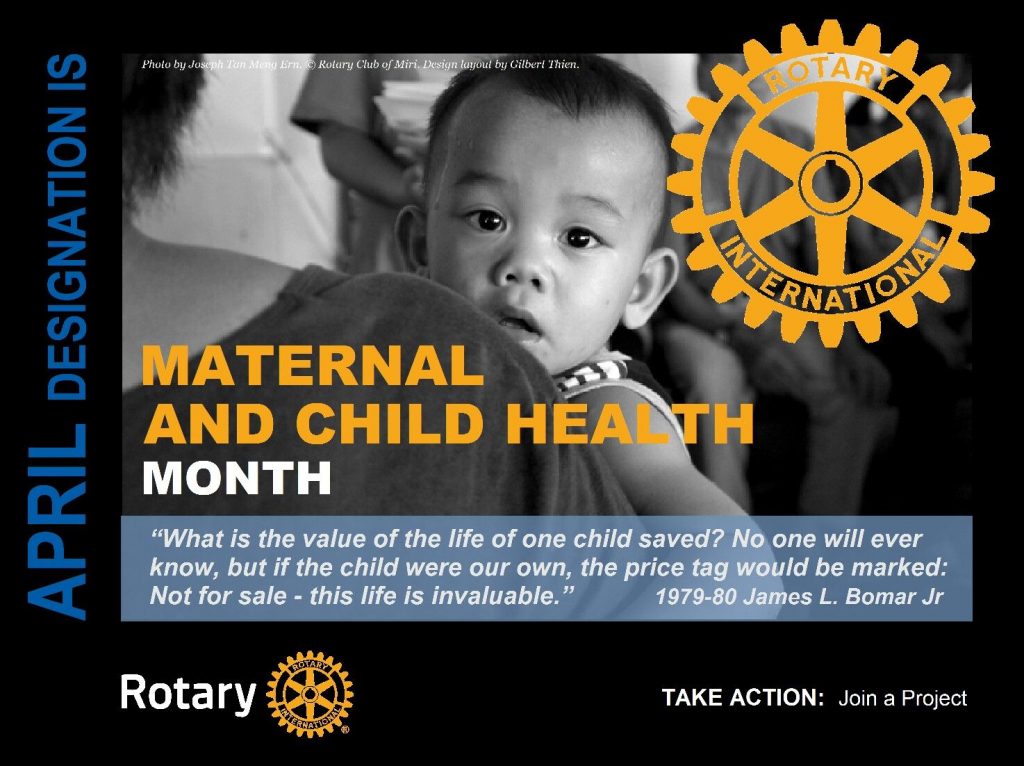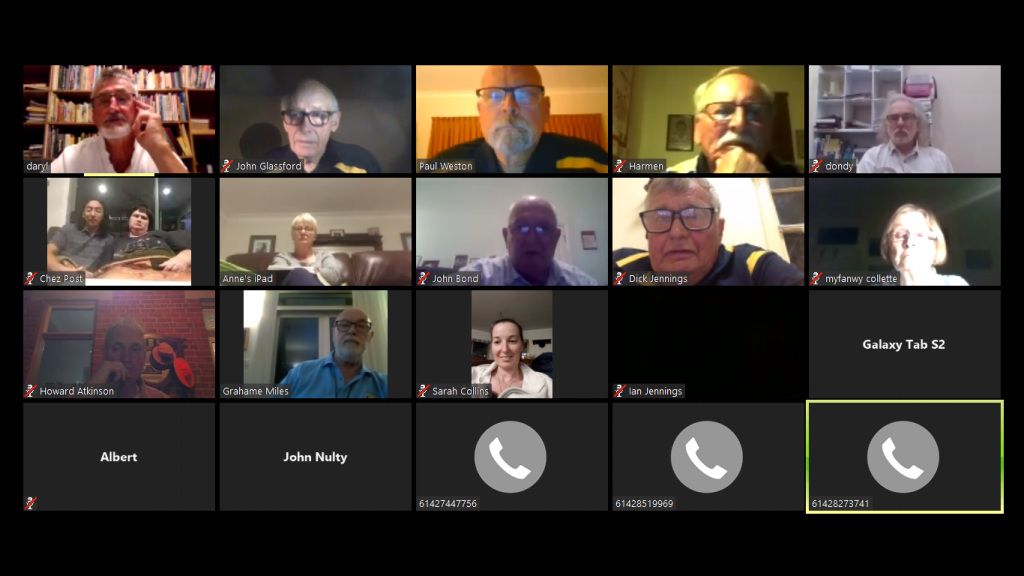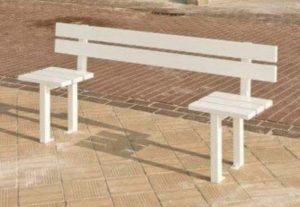Meeting of April 6th
[There was no meeting on April 13th because of the public holiday.]
President Daryl welcomed 18 members and two guests to our second Zoom meeting, which will be our standard way of meeting until restrictions related to the COVID-19 pandemic are eased. Present in the virtual meeting room were members Daryl, Paul, John G, Henk, Grahame, Ian, Don, Anne, Alex, Albert, John B, Bernadette, Garth and Leslie. Visiting Rotarians included David Benn (Rotary Club of Wagga Wollundry) and Chip Ross (Rotary Club of Strathcona Sunrise, BC Canada). One guest (Chez Post) also attended. Apologies received from Myffy Collette, Neil Munro and Dick Jennings (eye accident).
President Daryl opened the meeting and welcomed our visiting Rotarians and our guest.
Henk Hulsman read the correspondence which included Rotary Down Under increase in annual cost of RDU magazine ($44/annum), letter of thanks from Marg Perkin for the gift that Grahame purchased for Marg on our behalf, and Coolamon Shire Council bill for the community hall hire for our last bingo.
Paul Weston advised us that his daughter Nicole who lives in New York City may have contracted the virus, however Nicole is well and believes that she is now immune and is back at work (working from home).
Alex and Chez have been weeding and walking the dogs.
Don said it was a good time to plant the trees. Ian feels that they are best done in the spring after another ripping. Albert suggested that water-retention crystals be used, regardless of when planting occurs.
Daryl thanked Henk and Albert for helping to complete the caravan shed.
David Benn says that Wollundry will start using Zoom soon and the Board has already met via Zoom.
Daryl said that Wagga Wagga was very quiet.
Chip Ross joined in and shared what is happening in Canada and noted that Canada was doing much the same as Australia. Chip spoke about his club and what they have done on the international Rotary scale which includes:
- Wheel chairs and prosthetic limbs for Chennai in India.
- Water projects in Mexico together with their District 5060 and the Rotary Foundation. They are looking at a suite of projects raising over $200-300,000 US$ and are working with WASRAG (and WASH.
- They will be supporting 4 villages in Mexico.
- Chip said they had the same problems with lack of toilet paper in Canada.
- Chip invited us to join his club one day on Zoom (our meeting started at 3 am for Chip!)
- John G presented Chip with $20 Canadian in return for Chip’s $50 Aussie that Chip gave to JG in 2005 at the Chicago Convention.
The re was no fine session or raffle, but we’re working on a way to implement virtual fines and raffles!
Daryl closed the meeting at 8:35 pm and thanked everyone for attending and said that it was a most enjoyable meeting. Our next regular meeting will take place on April 20th at 7:30 pm (via Zoom).
Coronavirus Update
Editor’s note: over the next few weeks, I’ll be including informational pieces on viruses in general and the coronavirus in particular. After doing a bit of reading on the topic, I thought sumarising this information in non-technical terms might help members to better understand the nature of viruses and the biological basis of the current pandemic.
Part 3 – How viruses cause illness. Recapping from the previous two instalments, viruses are not living things, but are able to reproduce (replicate) by getting cells of a host organism to “read” the genetic material they carry and then manufacture more virus particles (the genetic material plus the protein coat that surrounds it). COVID-19 is caused by an RNA virus, a group of viruses that includes the viruses that cause the common cold, polio and SARS (a respiratory virus that threatened the world several years ago, but then fizzled out). The virus that causes COVID-19 (the name given to the disease) is technically referred to as SARS-CoV-2 and likely originated from a virus that infected bats. Most viruses attack organisms only within one species, which is attributed to the presence of proteins on the surface of the virus that can only invade cells that have the appropriate receptor protein that can bind to the surface protein. The virus SARS-CoV-2 is most genetically similar to a virus that infects bats, but a genetic change must have occurred to allow its surface protein to bind to proteins found in humans, perhaps after transitioning through a third organism. This is what happened when SARS appeared several years ago; a virus from bats jumped to civet cats after a surface protein mutation occurred, and from civet cats it transitioned to humans. In any event, 2019-nCov makes its home in the cells of humans, causing the disease known as COVID-19. How does COVID-19 kill people? When viruses invade our cells, the body recognises the foreign bodies and mounts a defence, which has two main stages, a short-term, rapid response by leukocytes (also called “killer cells”) and a longer-term, more targeted response that produces antibodies that neutralise the invader. As people age, they produce fewer of the cells that generate antibodies, which leaves most of the defence up to the non-specific killer cells. One of the main tools of the killer cells is the production of cytokines, which have the unfortunate side-effect of causing inflammation. The inflammation caused by SARS-CoV-2 is centred in the lungs because there are more of the receptor proteins that bind to the viral protein there than in other tissues. The inflammation in the lungs impedes oxygen exchange, which accounts for the breathing difficulty associated with COVID-19. Besides older people, those with chronic respiratory problems or cardiovascular impairment are at increased risk of dying from COVID-19, but there is much we don’t know about the virus because young, apparently healthy people have also succumbed to the illness. In the next instalment, we’ll look at transmission of coronavirus and the rationale behind strategies being used to control the societal impact of COVID-19. – Paul Weston
JUST FOR LAUGHS
THE PUZZLER
Answer to last puzzler: The answer was a net.
DIARY
NB: All face-to-face Rotary events have been cancelled until further notice because of the coronavirus pandemic. Board meetings will be held as previously scheduled but will be virtual meetings (conducted via Zoom). Regular meetings will be held via Zoom on a trial basis starting on 30 March.
Monday, April 20th – Zoom meeting. 7:30-9:00 pm. See meeting invitation in SMS or email message sent to members for login details.
Sunday, April 19th – DisTec20 (District 9700 technology workshop), Young.
Saturday, April 25th (ANZAC Day) – Catering for Trotting Club, Coolamon Showgrounds.
Saturday & Sunday, May 16th & 17th – District Assembly, Young. Income board members expected to attend.
Monday, May 18th – Club Assembly. Coolamon Sport & Rec Club, 6:30 for 7 pm.
Wednesday, May 20th – Board meeting. Zoom, 7:30-8:30 pm.
June 6-10th – RI Convention, Honolulu.
Wednesday, June 17th – Board meeting. Zoom, 7:30-8:30 pm.
*Monday, June 29th – Coolamon Rotary Changeover. Coolamon Sport & Rec Club.
* denotes partner & guest night
REMINDERS
Please get your working with children check completed and give the number and expiry date to the secretary ASAP. Failure to do so may mean you are not covered insurance wise when you volunteer at events.



